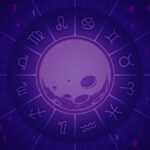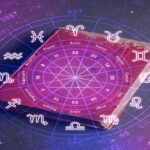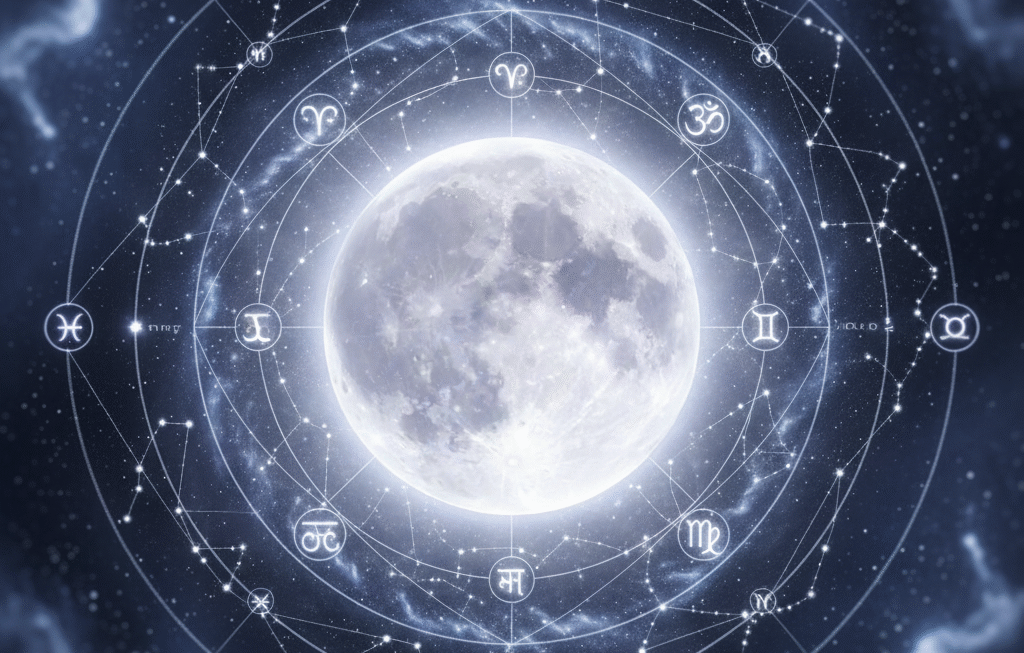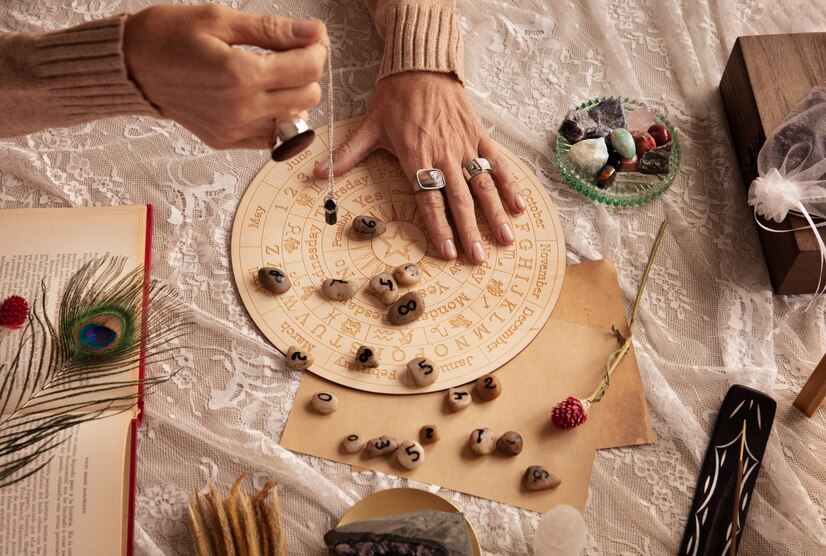This analysis delves into the traditional Jyotish (Vedic Astrology) methods for assessing Relationship Compatibility, commonly known as Kundali Matching or Porutham. We examine this practice from traditional, contemporary, student, and practical perspectives, focusing on the Ashtakoota Matching (8-point Nakshatra compatibility) system while acknowledging other crucial factors like Manglik Dosha Analysis, Bhava comparison, Graha placements (esp. Shukra/Guru), and Navamsa (D9) chart synergy. Understanding Vedic compatibility analysis provides insights into energetic harmony, potential challenges, and the karmic dimensions of relationships.
LENS 1: Traditional Foundation (The Classical Jyotishi’s View)
Key Findings: Traditionally, assessing compatibility before marriage is a deeply ingrained practice aimed at ensuring harmony, longevity, prosperity, and progeny. The primary method involves comparing the Janma Nakshatras (birth Nakshatras based on Moon’s position) of the prospective couple using the Ashtakoota Matching system, which assigns points (Gunas) out of a possible 36 based on eight criteria. A higher score (typically above 18) indicates better energetic compatibility. Checking for severe afflictions like Manglik Dosha (Kuja Dosha) is also paramount.
Detailed Analysis:
The Ashtakoota (or ‘Guna Milap’) system evaluates:
- Varna: Spiritual/ego development compatibility.
- Vashya: Mutual attraction/control dynamic.
- Tara/Dina: Compatibility based on birth stars’ distance, indicating fortune/longevity.
- Yoni: Sexual compatibility and primal instincts.
- Graha Maitri: Psychological compatibility based on friendship/enmity between Moon sign lords.
- Gana: Temperament compatibility (Deva/Divine, Manushya/Human, Rakshasa/Demonic).
- Bhakoot/Rashi: Compatibility between Moon signs, affecting family welfare/emotions.
- Nadi: Health, progeny, and hereditary factor compatibility (considered most important). Beyond Ashtakoota, traditional analysis heavily weighs Manglik Dosha Analysis (Mars in 1st, 4th, 7th, 8th, 12th houses – requires careful assessment and check for cancellations) and the strength/placement of the 7th Bhava (partnership) and its lord (Bhavapathi), and Shukra (Venus – Karaka for marriage/love).
- Technique Deep Dive: Nadi Koota: This carries the highest points (8 out of 36). Couples having the same Nadi (Adi/Vata, Madhya/Pitta, Antya/Kapha) is traditionally considered highly inauspicious, primarily linked to health issues for progeny. Checking this is critical in traditional matching.
- Expert Insight (Traditional Source): “Marriage unites two souls based on karmic ties. Kundali Matching assesses the inherent harmony and potential challenges between the individuals’ karmic patterns, aiming for a stable and dharma-aligned union.” – Principle reflecting classical Jyotish view.
- Hidden Wisdom: Beyond Ashtakoota: Classical texts mention other compatibility factors, including Mahendra Koota (prosperity/longevity), Stree Deergha (wife’s well-being), Rajju (potential for widow/widowerhood – highly sensitive), and Vedha (afflictions), showing Ashtakoota isn’t the only traditional method.
- Astrological Framework Map Suggestion: A table listing the 8 Kootas, their maximum points, and the factor they assess (e.g., Nadi – Health/Progeny – 8 points). Highlight Manglik Dosha placements.
- Critical Considerations: Over-reliance solely on the Ashtakoota score is a common mistake; a high score doesn’t guarantee happiness if severe afflictions like Manglik Dosha exist or if the 7th houses are poorly disposed. Conversely, a lower score might be acceptable if other factors are strong and mitigating combinations exist. Context is crucial.
LENS 2: Contemporary Interpretation Framework (The Modern Jyotishi’s Approach)
Key Findings: Contemporary Jyotish respects traditional methods like Ashtakoota and Manglik Dosha checks but integrates them with a broader analysis of psychological compatibility, individual needs, and overall chart synergy. The focus shifts from a simple ‘pass/fail’ score towards a nuanced understanding of potential strengths and challenges in the relationship, empowering conscious choice.
Detailed Analysis:
Modern practitioners still calculate Ashtakoota scores but interpret them more flexibly, considering them as indicators of innate energetic resonance or friction. Manglik Dosha Analysis is done carefully, looking for cancellations and interpreting it more as a sign of high energy or potential conflict requiring management, rather than an absolute barrier. Great emphasis is placed on:
- Comparing Lagnas (Ascendants): For overall life path compatibility.
- Comparing Chandra Rashis (Moon Signs): For emotional understanding and mental compatibility (partially covered in Ashtakoota but analyzed deeper).
- Shukra (Venus) placements: For love expression, values, and attraction.
- Guru (Jupiter) placements: For shared beliefs, wisdom, and fortune (especially Guru as husband Karaka).
- Inter-chart aspects (Drishti): How one person’s planets aspect the other’s.
- Navamsa (D9 Chart) Comparison: Considered crucial for assessing the deeper compatibility, dharma alignment, and true potential of the marriage.
- Technique Deep Dive: Navamsa (D9) Synergy: Comparing the Lagnas, Moons, 7th houses/lords, Venus, and Jupiter placements in the Navamsa charts of both individuals provides profound insights into the subconscious compatibility and long-term stability of the union, often overriding a moderate Ashtakoota score.
- Expert Insight (Modern Jyotishi): “Vedic compatibility analysis today aims for a holistic view. We honor the traditional Koota points for energetic resonance but integrate psychological insights from planetary placements and Navamsa analysis to understand how a couple can consciously work with their unique dynamics.” – Contemporary Jyotish Practitioner.
- Alternative Approaches: Some may incorporate relationship psychology concepts alongside Jyotish analysis, focusing on communication styles (Budha), conflict resolution (Mangal), and shared values (Shukra/Guru).
- Astrological Framework Map Suggestion: A layered diagram. Core: Ashtakoota/Nakshatra matching. Middle Layer: Manglik Dosha check, 7th House/Lord analysis, Shukra/Guru comparison. Outer Layer: Navamsa D9 analysis, Inter-chart aspects.
- Critical Considerations: Dismissing traditional methods like Ashtakoota entirely can mean missing valuable insights into core energetic compatibility. However, rigidly adhering to scores without considering the whole chart context (including psychological factors and Navamsa) is equally flawed. Balance is key.
LENS 3: Learning Path Analysis (The Student’s Perspective)
Key Findings: Students must learn the Ashtakoota system calculation and interpretation, understand the rules and cancellations for Manglik Dosha, and then progress to synthesizing this with overall chart comparison, including Navamsa analysis. It requires integrating multiple techniques.
Detailed Analysis:
Learning involves memorizing the 8 Kootas, their point values, and what they signify. Calculating the score based on the couple’s Janma Nakshatras is a core skill. Understanding the different house placements for Manglik Dosha and its common cancellations (e.g., Mars in own sign/exalted, benefic aspects, placement for both partners) is crucial and complex. Students then learn to evaluate the 7th house/lord, Shukra, Guru, and compare Lagnas/Moons in both Rasi and Navamsa charts. Vedic Relationship Compatibility is a multi-step process.
- Real-World Application: Practicing Ashtakoota calculations for known couples. Analyzing the charts of happily married vs. struggling couples to see how different factors (Koota score, Manglik Dosha, Navamsa) play out. Understanding one’s own relationship patterns through personal chart analysis.
- Student Question: “If the Ashtakoota score is low (e.g., below 18), does it mean the marriage will definitely fail?” Answer: Not necessarily. A low score indicates potential energetic friction or lack of natural harmony in certain areas. However, strong placements of 7th lords, Venus, Jupiter, good Navamsa compatibility, and conscious effort by the couple can overcome a low score. It highlights areas needing more work and understanding. Conversely, a high score doesn’t prevent issues if other severe afflictions exist.
- Expert Insight (Jyotish Student): “Learning compatibility felt like putting together a complex puzzle. Ashtakoota was the first piece, then Manglik Dosha, then 7th house analysis, then Navamsa… seeing how they all fit together to create the full picture was challenging but incredibly insightful.”
- Common Misconceptions vs. Reality: Misconception: Kundali Matching is only about the Ashtakoota score. Reality: It’s a crucial part, but comprehensive matching includes Manglik Dosha, 7th house/lord analysis, key planet comparisons, and Navamsa charts. Misconception: Manglik Dosha means one partner will die. Reality: This is a harmful myth. It indicates potential conflict, high energy, or challenges within the marriage dynamic that need careful handling and understanding, not necessarily widowhood.
LENS 4: Practical Implementation (The Jyotish Practitioner’s Application)
Key Findings: Practical Kundali Matching involves a systematic assessment of multiple factors – Ashtakoota, Manglik Dosha (with cancellations), Bhava comparison, planetary synergy, and Navamsa analysis – to provide a balanced perspective on a relationship’s potential strengths and challenges. It aims to guide, not dictate, relationship decisions.
Detailed Analysis:
Consultants perform a step-by-step analysis:
- Calculate Ashtakoota score and analyze individual Koota results (esp. Nadi, Bhakoot, Gana).
- Check for Manglik Dosha in both charts and assess cancellations accurately.
- Analyze the 7th house, 7th lord, Shukra (for males also), and Guru (for females also) in both Rasi charts.
- Compare Lagnas and Chandras for fundamental compatibility.
- Crucially, compare key factors (Lagna, Moon, 7th house/lord, Shukra, Guru, Atmakaraka) in the Navamsa (D9) charts.
- Synthesize all findings to offer nuanced advice on compatibility, potential issues, and areas requiring conscious effort. Jyotish Compatibility Analysis is a detailed process.
- Real-World Application: Helping families assess potential matches for arranged marriages. Guiding couples already in relationships to understand their inherent dynamics and challenges better. Advising on potential mitigating factors or remedies (Upayas) if significant incompatibilities exist but the couple is committed.
- Technique Deep Dive: Analyzing Bhavat Bhavam for Relationships: Looking at the 7th house from the 7th house (i.e., the Lagna) for self’s impact on partnership, or the 5th house (love/romance) from the 7th house (i.e., the 11th house) for gains/desires from partnership, adds subtle layers.
- Expert Insight (Jyotish Consultant): “My goal in Kundali Matching isn’t just to give a score, but to illuminate the energetic blueprint of the potential relationship. Where will there be natural flow? Where might friction arise? Understanding this allows the couple (or family) to make informed decisions and consciously build a stronger foundation if they proceed.”
- Practical Tip: While Ashtakoota is important, pay special attention to Graha Maitri (friendship between Moon sign lords) and Bhakoot (distance between Moon signs) for psychological and emotional harmony, and Nadi for health/progeny factors. Don’t solely rely on the total score.
- Chart Example Suggestion: Side-by-side comparison of two charts, highlighting compatible Nakshatras (good Koota score), cancellation of Manglik Dosha, and strong 7th lord placements, indicating a favorable match despite potential minor issues.
PERSPECTIVE INTEGRATION MATRIX
| Feature | Traditional View | Contemporary View | Student Focus | Practical Use | Integration Point |
| Primary Method | Ashtakoota, Manglik Dosha Check | Holistic: Koota + Chart Synergy | Master Koota & Manglik Rules | Assess Harmony/Challenges | Holistic view (contemp) incorporates traditional methods (trad) learned by students (student). |
| Key Factors | Nakshatra Match, Mars Position | Navamsa, 7th Lord, Venus/Jupiter | Calculate Score, Identify Dosha | Guide Relationship Decisions | Navamsa check (contemp/prac) adds depth to Nakshatra match (trad/student). |
| Goal | Ensure Stability/Progeny | Understand Dynamics, Guide Choice | Learn Calculation & Synthesis | Nuanced Advice, Identify Red Flags | Understanding dynamics (contemp) helps provide nuanced advice (prac) beyond stability checks (trad). |
| Interpretation | Point-Based, Rule-Oriented | Nuanced, Psychological Context | Balance Score vs. Whole Chart | Balanced Perspective, Remedies | Balancing score/rules (student/trad) with context (contemp) allows for balanced advice (prac). |
MISCONCEPTION ANALYSIS
| Common Belief | Jyotish Reality |
| A high Ashtakoota score (>28) guarantees happiness. | A high score indicates good energetic compatibility but doesn’t guarantee happiness, which depends on many other chart factors, free will, communication, and mutual effort. |
| Manglik Dosha means marriage is impossible/doomed. | Manglik Dosha indicates potential challenges related to energy/conflict in marriage. It has many cancellations and can often be managed with awareness and compatibility elsewhere. |
| Kundali Matching is only for arranged marriages. | While traditional in arranged marriages, many couples in love matches also consult Jyotish for compatibility analysis to understand their relationship dynamics better. |
| Online matching calculators are sufficient. | Online calculators usually only provide the Ashtakoota score and basic Manglik check. They miss crucial analysis of house lords, Navamsa, and specific planetary conditions needed for reliable assessment. |
KEY DEVELOPMENTS & FUTURE DIRECTIONS (Evolution Timeline)
- Classical Period: Ashtakoota system and other Koota methods based on Nakshatras developed. Rules for Manglik Dosha codified. Emphasis on 7th house, Shukra, Guru.
- Medieval Period: Further commentaries and regional variations in Koota systems and Manglik Dosha interpretation.
- Modern Period: Increased emphasis on psychological compatibility alongside traditional methods. Navamsa chart comparison gains prominence. Awareness of Manglik Dosha cancellations becomes more widespread.
- Contemporary: Software enables quick calculation of Kootas and detailed chart comparison. Integration of communication styles (Budha) and emotional needs (Chandra) analysis alongside traditional points. More nuanced, less fatalistic interpretation of challenges.
- Future: Continued research correlating specific Koota points or inter-chart aspects with long-term relationship success/challenges, further integration of psychological principles within the Vedic framework, development of more sophisticated compatibility algorithms (used cautiously).
SYNTHESIS & RECOMMENDATIONS (Celestial Integration)
Vedic relationship compatibility analysis is a multifaceted process designed to assess the potential harmony and challenges between two individuals based on their karmic blueprints. Integrating perspectives means honoring the insights from traditional Nakshatra matching (Ashtakoota Matching) and Manglik Dosha Analysis (Traditional), enriching this with broader chart synergy including Navamsa comparison and psychological factors (Contemporary), mastering the complex calculation and synthesis involved (Student), and using this holistic understanding to provide nuanced, responsible guidance (Practical). Kundali Matching is a powerful tool for understanding relationship potential when used wisely.
Recommendations:
- Prioritize Holistic Analysis: Don’t rely solely on the Ashtakoota score or Manglik status. A comprehensive analysis considers the entire chart.
- Assess Key Factors: Pay attention to Ashtakoota (esp. Nadi, Bhakoot, Gana, Graha Maitri), Manglik Dosha (with cancellations), 7th house/lord, Shukra/Guru placements, and Lagna/Chandra compatibility in both Rasi and Navamsa charts.
- Navamsa is Crucial: Always examine the D9 Navamsa chart for deeper insights into compatibility and the marriage’s potential.
- Seek Qualified Expertise: Kundali Matching is complex. Consult experienced Jyotish practitioners for reliable analysis, especially for significant life decisions like marriage.
- Use as Guidance, Not Dogma: Compatibility analysis provides insights into potential dynamics, not immutable destiny. Conscious effort, communication, and mutual respect are vital in any relationship.
FURTHER AREAS OF STUDY
- Introduction to Nakshatras (Lunar Mansions) (The basis for Ashtakoota)
- Navamsa (D9) Chart Deep Dive (Crucial for relationship potential)
- Manglik Dosha (Kuja Dosha) In-Depth Analysis
- Shukra (Venus) in Jyotish (Karaka for love and marriage)
- Guru (Jupiter) in Jyotish (Karaka for husband, wisdom in relationships)
- The 7th Bhava (House) and its Lord in Jyotish












